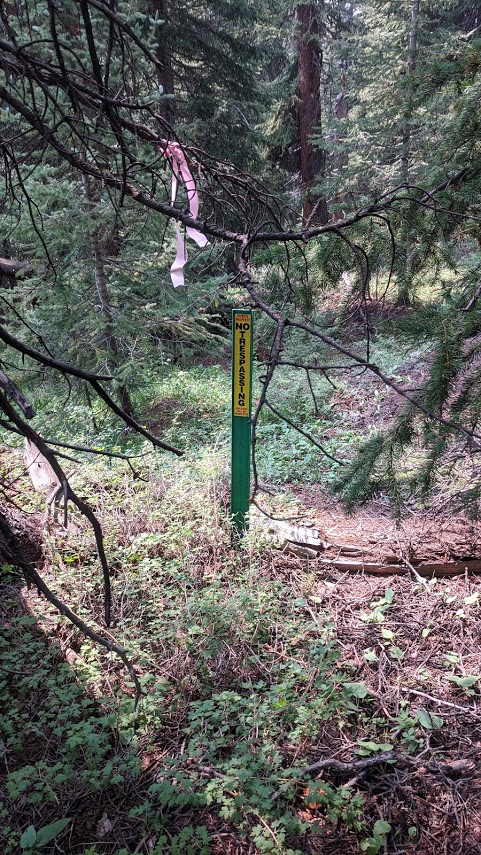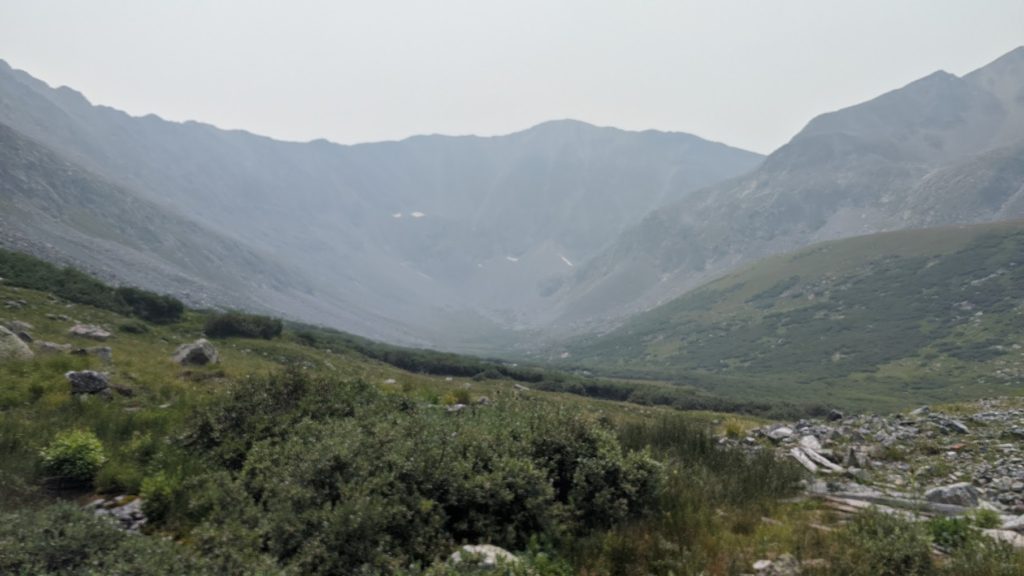
The ownership of history is contentious: while private collections of artifacts are sometimes scorned, and the taking of them from public lands is outlawed, much of history is kept behind glass cases, accessible only to a handful of credentialed elite, or otherwise left rotting in sterile cardboard boxes in storage facilities. Even more difficult is history in bulk, which can only be accessed on land, and is therefore subject to the incredible complexities of land ownership, law, and precedence.
Although my favorite valley has been a wonderful source of historical adventure and continues to surprise me every time I return to its ancient slopes, I also know that there is a wide world of artifacts beyond. Some of the best finds cannot be located on a map but have to be stumbled upon by happenstance. Others, however, leave traces that can be seen in satellite imagery: timbers busted apart by time, patterns in the earth, trails, even. I find that switchbacks to mining adits are very easy to spot when the imagery is taken during the winter. I recently took to the skies once more to investigate even more remote valleys, and I wasn’t disappointed.
The tailings pile stuck out like a soar thumb. It was unmistakably mining-related. On each side appeared to be the ruins of large buildings, their timbers scattered across the mountainside. Farther up the valley, and much less conspicuous, were a series of vertical slats, likely the remains of a roof or foundation. You have to train your eye to find these, but once you do, you begin to see them everywhere. These two locations looked like promising explores. But there was just one issue: could they actually be reached?
The first problem was that no trail led back to these ruins. In some ways that made them more intriguing. After all, those ruins that are easy to reach have usually been destroyed over the past 100 or so years. Many have been looted, pieces sold off for pennies at antique stores and internet markets, a sad fate for something that’s supposed to belong to the people. But other times, the sheer effort involved to reach some locations has been enough to deter the ill-intentioned and these locations, I have found, make for some of the very best discoveries.
But bushwacking isn’t easy. And to complicate things even further was something I hadn’t anticipated: half the valley was private property.
Easement access to public land is not an uncommon problem. Stories abound of ranchers threatening and even killing people for trespassing, even along established trails that cut through tiny sections of private land. Both sides assert their rights, and often nobody truly wins. Some owners are actually well-intentioned, and leave their roads un-patrolled because they hope to give the public access, but then sometimes yahoos come along and begin destroying things, or taking the access for granted, and at that point, some owners decide enough is enough. For every bitter and tyrannical landowner, there is usually a story of how they became that way.
Public land is a double-edged sword like this: it gives people freedom to enjoy nature, but it also gives them freedom to be evil and disrespectful.
I decided to push my luck. Even now I have mixed feelings about this. Because here’s the truth: the other side of the valley had National Forest access. However, that side also had no trail. If I were to be found by somebody from the company that owns the land on the other side, it would only be natural for them to assume I had trespassed. Who in their right mind would choose to navigate through dense willow fields? Even if you took pictures along the way, even if you were perfectly within your rights, you are better off avoiding an angry confrontation if you can help it. I knew that the chance of this happening was extremely rare, but I was on edge the entire time. And at a certain point you have to ask yourself, if this is the case, should you really be back there at all?
Trails are a blessing. You can follow them, and if they are well-enough established, you can almost turn your brain off, relax, and focus on the beauty of your surroundings, while only needing to put one foot in front of the other. You never realize how much of a blessing trails are until you are forced to navigate without one. Fortunately for me, game trails saved the day. They led the way through some of the dense forest, though they often disappeared randomly and left me to find my way again. They led out of the trees and into the willow fields, where I lost them once more, and had to navigate by eye, by gut.
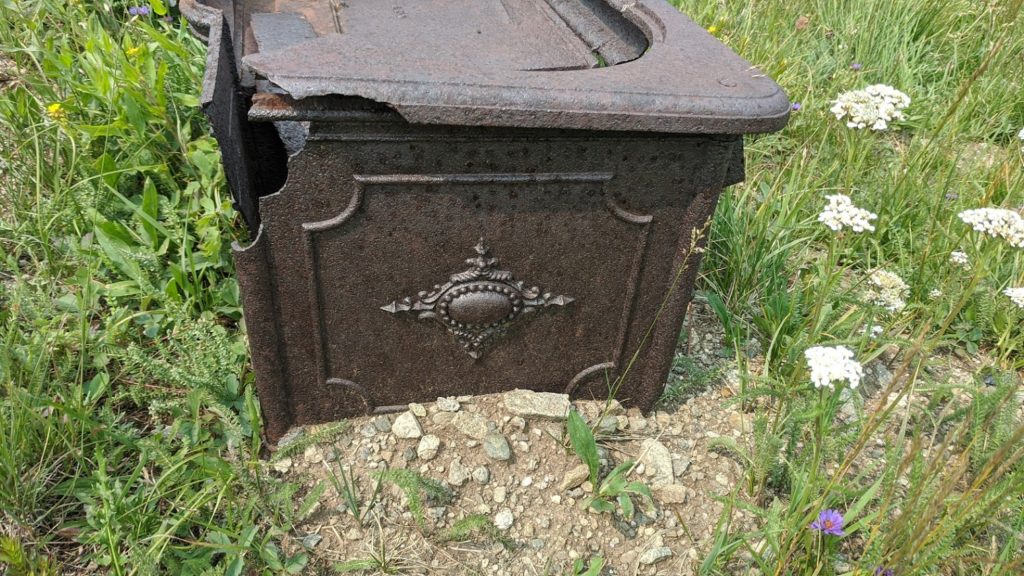
The process is painful. You head straight up the mountainside. You find the way blocked. You take a stab at a path lower down. You find it works. Other times, you head up because that’s the only way. But always, you keep your eyes on the opposite side of the valley, scanning for the presence of others, and doing your very best to stay away from the stream, that contentious and turbulent land where the lines on maps cross and the world obscures itself into difficult boundaries.
At last, after hours, you arrive, and the ruins are there in all of their glory.
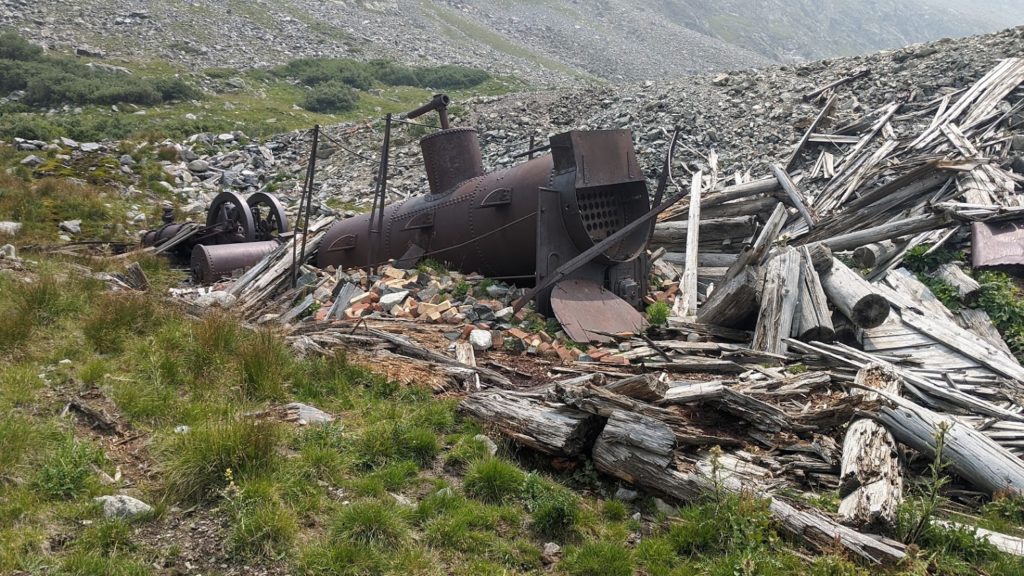
This piece of land was firmly in National Forest. But even then, I was leery of walking out onto the tailings pile and announcing my presence to the wide world. I witnessed the largest boiler I have ever seen; in fact, the only boiler I have ever seen in the backcountry, also, what appears to be an Ingersoll air compressor. There was more on the other side of the tailings: beams as thick as a torso. Shattered glass. Stone foundations. I had made it. These are the places I thrive.
I was exhausted from the endeavor, and I legitimately feared whether I would be able to find my way back. This had been an enormous mining operation, and it made me suspect that the aerial imagery of ruins I had seen deeper in the valley may have been the boarding house. But visiting that wasn’t to be. Several more willow fields were in my path, and it was already 1pm, and I was only half-way through the day. I decided, somewhat regretfully, that I would need to count my blessings and resist the urge to push my luck farther. I turned back here.
The day was successful. I reach the big ruins. I explored the valley. From some angles, this could be thought of as a giant “f- you” to the big corporation that owns half the valley and has done a decent amount to discourage it’s exploration. But I didn’t feel that way. It’s not that easy. It’s never that easy. I don’t believe I have ever seen such pristine ruins on my excursions. I could not find a single bullet hole anywhere. What at first looked like one was actually a perfectly machined space for a rivet that was no longer present. There was no graffiti. Everything had simply been left to decay into the mountainside, the way it should be. And the painful truth is…the reason these were so perfectly preserved was precisely because they were so off-limits. The company, as much as it seems they couldn’t care less about the history of this valley, or any of the valleys they own, had actually inadvertently done a great deal to preserve it. I guess what I really felt was a sense of elation to have made it back there. But I’m not a vandal, nor a thief, nor a looter. I’m just one of those guys who’s crazy enough to find a way because he loves to experience history up close.
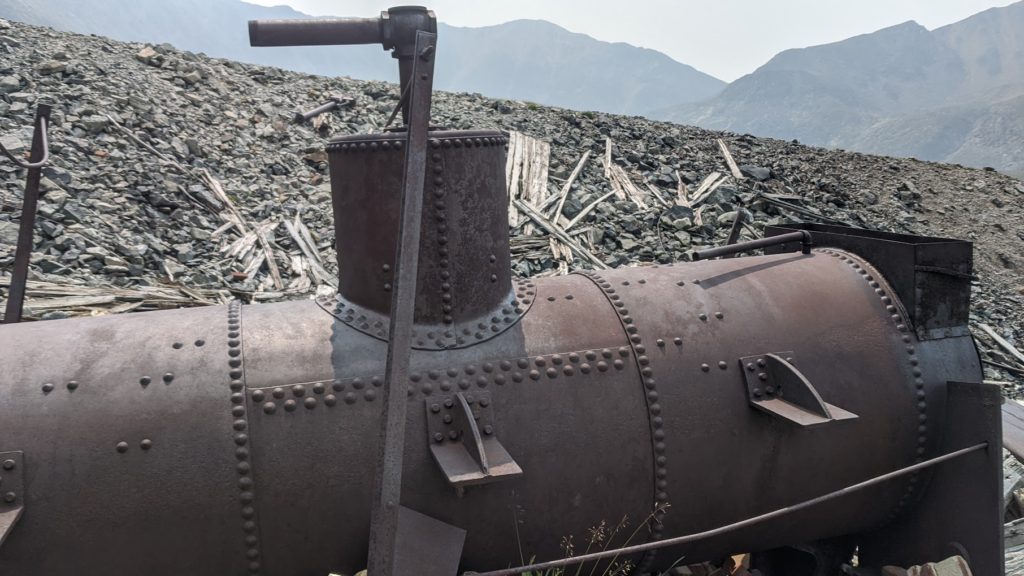
When I returned home, I realized that my path was off. I should have brought a property map. That was careless and stupid, not a mistake I want to make again. It turns out, the actual path through Nation Forest land is very nuanced, and my online sources were quick to disclaim any liability, meaning I had probably needed to up my game and contact the county for precise data. I was excited to find on the way back, however, that the route I started was dead accurate and successfully avoided the land that had No Trespassing signs all over it. But it was then that I realized it was in the company’s best interest to discourage people from going back, not because there isn’t a valid path (there certainly is), but because it’s so difficult to prove, and all they would be doing, the entire way, is encouraging people to trespass farther on. It’s difficult to dislike a company that prefers to avoid trouble, rather than prosecuting people. Even their signs near the popular locations at the start of the valley were kind: “Please respect private property stay on trail”. That doesn’t sound like somebody trying to squelch adventure: that sounds like somebody who wants to avoid trouble.
I have mixed feelings about my adventure, and I don’t know that I will ever go back. The ruins farther up the valley beckon with their riddles, but there are only so many riddles you can hope to solve in this life, and I’ll venture a gander that there are plenty of others I can hope to solve without cutting things so close, so to speak. For now, I think it’s okay to leave the Forbidden Cathedral in peace, and leave its imposing spires to the next adventurer, years from now, who may also come to revel in its glorious history.
